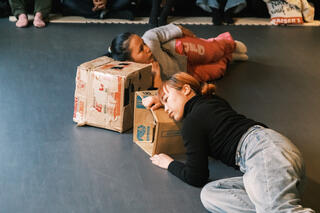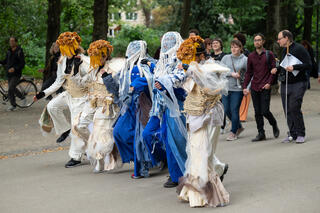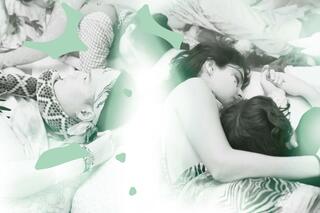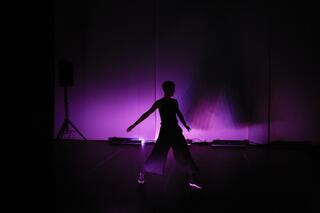Backstage with Ayaka Nakama and Ayu Permata Sari
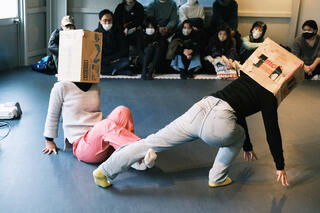
You will be at a three-week residence at tanzhaus nrw from February to March. You have been working together for two years already. How did that come about, and how did your collaboration develop?
Ayu Permata Sari: DANCEBOX in Kobe and Paradance Platform in Yogyakarta invited us to an exchange. At the start of 2022, we began online, due to the pandemic. In December of 2022, I visited Ayaka in Kobe, Japan, and Ayaka came to Lampung, Indonesia, from January to February 2023. The project offered much in the way of freedom – yet it also initially proved to be a challenge to me. How was I supposed to share something with another artist whom I had never met before? After that, our collaboration developed very organically, slowly, and it became quite multi-layered. Working with Ayaka is very special to me. We titled last year’s showing in Yogyakarta How Do We Understand Each Other?. This question, by now, has been of concern to us for two years.
Ayaka Nakama: This process with Ayu is special to me, too. I already have had experience with international artistic exchange projects, but this type of intense collaboration has been happening to me for the first time. This exchange is not only about the two of us; we included our friends and families. So many people support us and are involved in the project. That is what makes it so remarkable and exciting.
Could you describe how you approached your exchange in a specifically physical, dance, or choreographic manner?
Ayaka: As mentioned by Ayu, we could not meet physically during the first project year, due to the pandemic. So, we send each other a package. We could not travel to another country, yet the packages could. Therefore, we started our collaboration in an analogue way. We could have zoomed, but we originally wrote letters and selected several items we wanted to send each other. The objects Ayu sent me had an impact on my life. They were new things, and how I surrounded myself with these new things changed my body. When I eventually encountered Ayu physically it was not, in this sense, for the first time. I already felt near to her, and familiar. And when we worked on movements together, this feeling continued. The objects choreograph our movements in daily life. Because we come from different cultures, the objects sometimes are alike, sometimes they are different. Even if the item is the same, the way in which we use the item is different. We recognised so many differences in everyday movement sequences, and we were very interested in that. These processes proved very important for our choreographic exchange.
Ayu: The objects are signs of our collaboration, but also tools, a method for communication. The items were everyday objects. But Ayaka also sent me a dress, for example, and told me that she had worn it as a costume for one of her performances. I sent her a traditional fabric from Lampung. My background is in traditional Indonesian dance and I often wear this fabric when I dance. We now wear both when we work together.
I find it important to stress that our exchange was initiated randomly. That makes our collaboration random, in a certain way. Random, but with great ramifications for us. In Kobe, Ayaka and I went hot spring bathing. It is customary to be naked there in Japan. It was very strange for me to be bathing with so many other naked women – I am a Muslim woman, and even if I am alone in my bedroom, I need to cover my body with something. But I subjected myself to that. I had to experience it myself. When we move together, when Ayaka touches my body, when Ayaka talks and when we discuss, I believe that I can now better understand Ayaka, and that informs and inspires our choreography. We initially thought we needed to pick a topic for our collaboration. But we eventually decided that our relationship and its randomness, its depth, is our topic. Following our Yogyakarta performance, a friend of mine described how she felt we were like sisters.
I was quite taken by the description of your collaboration as a kind of sisterhood. To me, that term is connected to a feminist context. It symbolises solidarity and care. Maybe it is connected to other contexts for you. What do you mean to express with the term? And how do you practice that?
Ayaka: Biographically, we are connected by many things. Both of us are, for example, still unmarried, and this situation, at our ages, is rare in the societies we live in. I often think we are sisters because we support each other. I come from classical ballet where I perceived the existence as a dancer as being individual and competitive. Only later did I learn that dancers could work together and give each other mutual support, like Ayu and I do.
Ayu: For me, the collaboration with Ayaka is also characterised by feminist aspects. Our shared process is personal and defined by context. I deal with questions of being a woman and, yes, with marriage, for example – because my society puts forward certain gender-related expectations to me. In my dance pieces, I concentrate on gender equality in my culture. The value ascribed to family is very high in Indonesia. I often feel we care about each other too much, influence each other too much; that can sometimes prove inhibiting for me. Meeting Ayaka has been important to me in this regard. She inspired me to distance myself, to be a little bit more relaxed.
Let us talk about your respective artistic work. It strikes me that you both engaged with archiving and concerned yourselves with other movement material. Ayu, your solo performance Tubuh Dang Tubuh Dut, which will be shown at tanzhaus nrw during your residency, is based on intense research and the appropriation of movement material, is it not?
Ayu: Exactly. Tubuh Dang Tubuh Dut is based on embodiment, or on an embodied archive. I tried to capture the visitors’ movements at dangdut concerts. Those are very popular traditional music performances that draw on Arabic, Indian, and Malayan influence. As a dancer, at that time, I was very busy exploring when someone danced with the heart. During my education in Indonesia, this is what I heard all the time: Dance with your heart and be honest. I believe I dance with my mind. When I started to occupy myself with dangdut, I wanted to research a female singer at first. Dangdut singers are mostly read as female, and they move in a very sexy way. But when I participated in the dangdut performances, I was primarily impressed by the audience. The audience consists almost entirely of men, and many of them come from the working classes. They obviously enjoy dancing so much, and I joined them and felt their delight. That was 100 per cent with the heart. I was fascinated by the movements; they seemed unique to me. I realised I could see their work motions, the motions of their everyday lives, in their movements. Particular aspects of their lives are inscribed into their movements. Many people in Indonesia get around on motorcycles, for example. To start the engine, they must apply their hands in a defined way, and these hand motions resurface in their dance. As do hand movements of cooks who prepare meals. I began focusing on the guests’ bodies and to explore further, to question them on why they went to visit dangdut performances. In this way, I tell a lot about society with this piece.
You have also been touring widely with this solo. Another one of the piece’s aspects is the reflection of tension and power relations between performers and audience. It is about the aspect of being watched and being cheered upon and the joy of dancing. But how do you convey the specific references to Indonesian society in varying contexts?
Ayu: There is a big difference between showing the piece in Indonesia or internationally. Dangdut developed from the disenfranchised, financially weak social tiers. The songs tell of everyday problems and effort; they speak of life in Yogyakarta. People in Indonesia know and recognise Dangdut. Everywhere else, I have to communicate more via context, and I feel a responsibility to convey a certain amount of knowledge about my culture. I offer follow-up discussions after each performance.
Ayaka, you realised a site-specific performative project in public space that dealt with regional dance history and certain dance scenes in Japan for the festival Kyoto Experiment last year. Can you describe how you approached this and who you brought into this work?
Ayaka: I came up with the idea for The Odoriba Legend project during the pandemic, when many artists were producing videos about their work or started archiving their work online. I wanted to try a different approach, apart from utilising photos or videos, to archive dance. I started to get involved in the archiving of dance while at the same time being interested in the way how urban legends and folk tales are passed on. I wanted to create my own legend, and a new urban legend. As a first step, I collected stories about legends and interviewed professional dancers, choreographers, as well as spectators. I asked them to tell me about the legends they had seen or heard about over the course of their stage life. Theatres and art spaces are currently disappearing in Japan. Kyoto is changing a lot; there are hardly any freely accessible spaces within the city anymore. I was looking for those places and decided to build a large public stage for my project in collaboration with the Architecture collective Garage. I constructed a theatre and curated a programme for a week. And on the last day, we destroyed the theatre. So, this whole process is a project, a performance. To donate a new legend.
When you are dealing with dance history, you mostly encounter the same legends and superstars, such as Tatsumi Hijikata, or Pina Bausch. Yet there are so many more stories. And in the Kansai region – Kyoto, Osaka, Kobe –, the contemporary dance scene is different from the one in Tokyo. I live and work here, and I want to learn something about regional history. During my research, I was able to collect so many rumours and funny stories that are important to the development of the contemporary dance scene in the Kansai region. That is the reason I pick them up and create a project from these stories. I also asked a legendary choreographer to develop a piece for me, as a dancer, in this context. Fuyuki was the first to found and direct a contemporary dance company in the Kansai region, the Fuyuki Dance Vision. I opened the theatre to other artists, too; they held public rehearsals there and performed.
Here, you connect alternative forms of historicity with urban development and the loss of theatre and art spaces. That is very thrilling and consistent and simultaneously sad, to destroy the newly established stage again.
Ayaka: Rummaging through history, I found out that art spaces have always vanished, while others emerged anew, at all times. This has always been the case, at least for the Kansai region. Urban planning even forced private organisations to move, for better or worse, as the cities change. For example, DANCEBOX, a non-profit organisation for contemporary dance, was originally based in a newly built facility for urban development in Osaka, but the building was demolished due to Osaka City's deficit. It was lured to Nagata-ku, Kobe, a redevelopment area for earthquake reconstruction, and moved to its current location. The area around the vacant lot in Kyoto where The Odoriba Legend took place has its roots in the history of Japan's long-standing, discriminated Burakumin. There was a time when people were deprived of their freedom of marriage, employment, and education simply because they lived in this area. This prejudice continues to this day. To solve this problem, the government almost forcibly acquired this land and built municipal housing. Since then, the municipal housing has become dilapidated and has been demolished, and the question is how to make use of the vacant land. These contexts are not the main theme of my work. However, I learned about them in the process of my research. I became aware of the link between the emergence and the disappearance of spaces of art and culture, and histories of flight, work migration movements, and people having to leave their hometowns to begin again at a different place.
I noticed that both of you establish sustainable (institutional) infrastructures. Why is that important to you?
Ayaka: I am currently in the process of moving into my first proper own studio. The City of Kobe lends support. Two old buildings that have been vacant for a while now are being reshaped into rehearsal and work venues, also offering space for residencies. I am able to rent this complex at an advantageous price. The idea is that I share this space with other artists and the urban society. We call it house next door. I think this local integration is very important. I introduced myself to all the other neighbouring residents in the street before we opened. Many were pleased as well as highly interested. There was just one person voicing reservations we might be overly loud and disturbing. We talked at length, which I also like, this type of negotiation and mutual getting to know each other.
Ayu: I moved back into my hometown of Lampung, where my family supports me, from Yogyakarta. Little by little, we built a dance studio for me, we even laid the dance floor ourselves. It is not easy for me here; there are not many other artists here, no institutions. I believe it is important not to forget the small, more rural regions. And I find inspiration in working here, it challenges me. To many people, working in the dance field is not a proper vocation, and if you work from home, that is disparaged. But, step by step, I change people’s attitudes through my presence. I am very active, I teach, I invite other artists, we present works-in-progress and start conversations; I want to build and maintain a network.
Your work relates to a certain context as well as to local people and experiences. Finally, I am interested in your connection to the audience. Which experiences, which effects do you intend to evoke?
Ayaka: I like situations in which we are on an equal footing and share a common ground. I always try to get together with the audience, to be together. I enjoy performing in public spaces very much. For a performance in a theatre, the audience must buy a ticket and be interested in my work beforehand. I like to encounter people who have not done that.
Ayu: To me, art and the public sphere are always intertwined because I am a part of the public myself. The public is me, as well. I do not see myself as occupying a special position from without the public.
Thank you for this conversation!
Ayaka Nakama is a choreographer and dancer and lives in Kobe, Japan. Following her education, she participated as a stipendiary in a dance study programme in Kobe, organised by the Agency for Cultural Affairs and NPO DANCEBOX, at the Rambert School of Ballet and Contemporary Dance (London). She worked with Mika Kurosawa, Reina Kimura, Contact Gonzo, Toshiki Okada (chelfitsch), as well as others. While she is dedicated to the manner in which a body is choreographed by someone or something, she pursues a phenomenon of which she believes it can only be called dance. Her 2019 work Freeway Dance was presented in Europe at Kunstenfestivaldesarts Brussels, Centre Pompidou Paris as well as at the Berlin Festspiele. Ayaka Nakama won the 16th Kobe Nagata Culture Encouragement Prize in 2022. She is a Saison Foundation Fellow from 2022 to 2023.
Ayu Permata Sari is a choreographer and dancer from North Lampung, Indonesia. She founded the Ayu Permata Dance Project as a platform to support herself and her companions in the development of their practice. Since 2020, Ayu has been focusing more on the role of gender in the Lampung Pepadun tribe. Her work Kami Bu-ta earned her the Jasi Bakti Award of the Asian Technology Festival in Johor, Malaysia, in 2018. She toured with her solo Tubuh Dang Tubuh Dut, also in the German-speaking countries. Load? premiered at Zürcher Theater Spektakel in 2021. From 2022 until 2024, Ayu Permata Sari will be in a close collaboration with Ayaka Nakam. This exchange was initiated by Paradance (Yogyakarta) and DANCEBOX (Kobe).
Lucie Ortmann, dramaturge at tanzhaus nrw, posed the questions. She visited Ayaka Nakama in Kobe in December 2023 during her stay in Japan as Visiting Fellow of The Saison Foundation.
